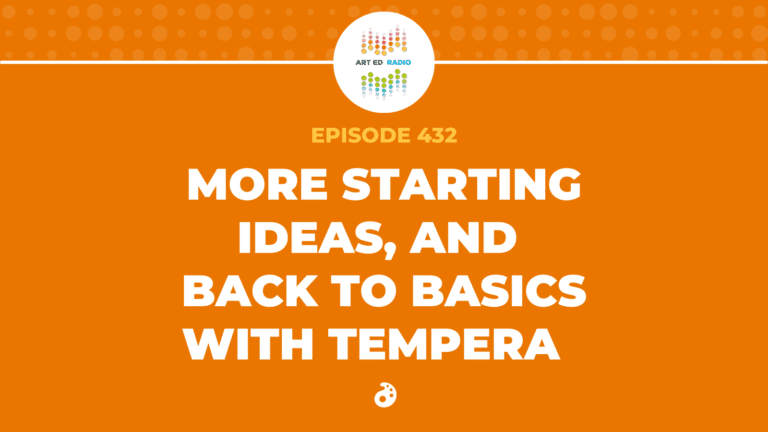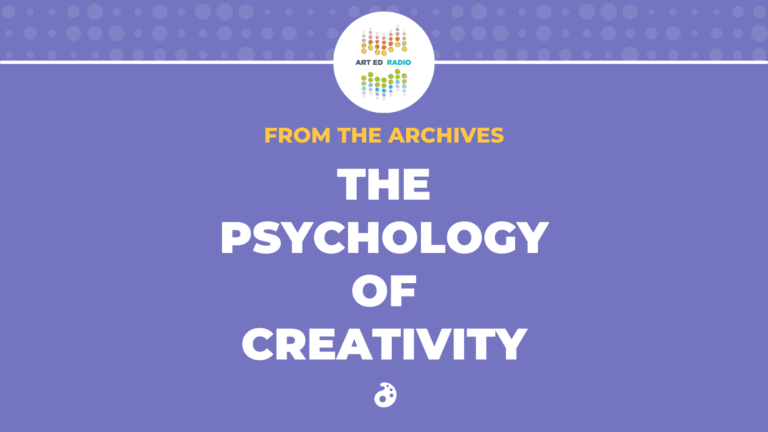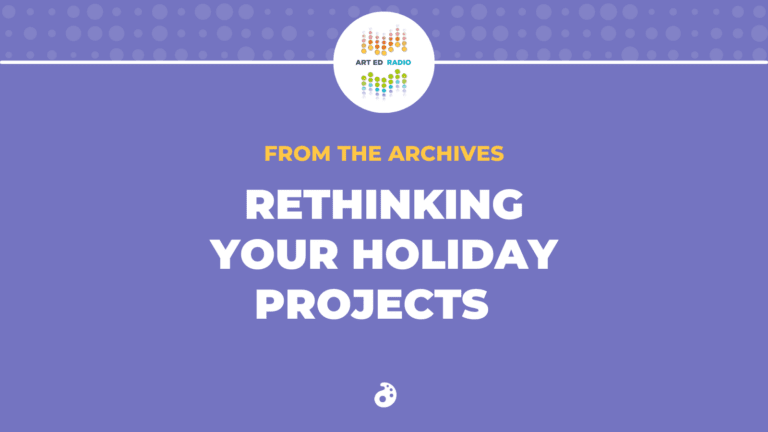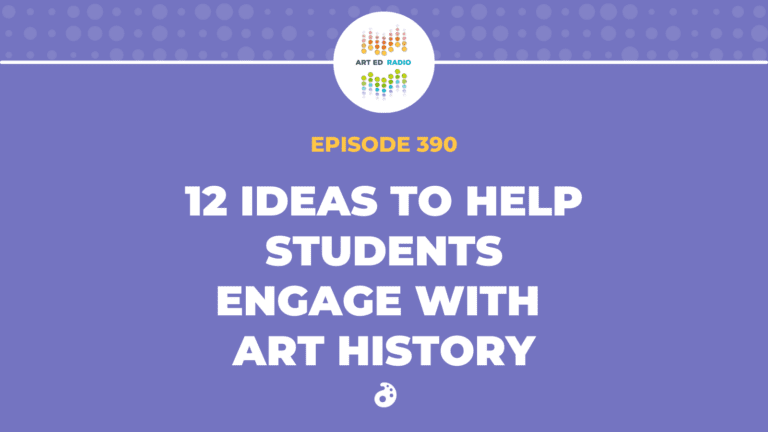Shannon Lauffer is back! In her last appearance on Art Ed Radio, talking about differentiation, she mentioned the use of student interest inventories. This time around, Shannon and Tim dive deep on how and why we should be using interest inventories, including discussions on what you need to know about your students, how inventories can help with idea generation, and how to create an inventory specific to your own classes. Full episode transcript below.
Resources and Links
- Shannon’s Last Appearance on Art Ed Radio
- Using Student Feedback to Improve Your Classes
- How to Use Student Surveys for Mindful Teaching
- 3 Essential Downloads for the First Days of School
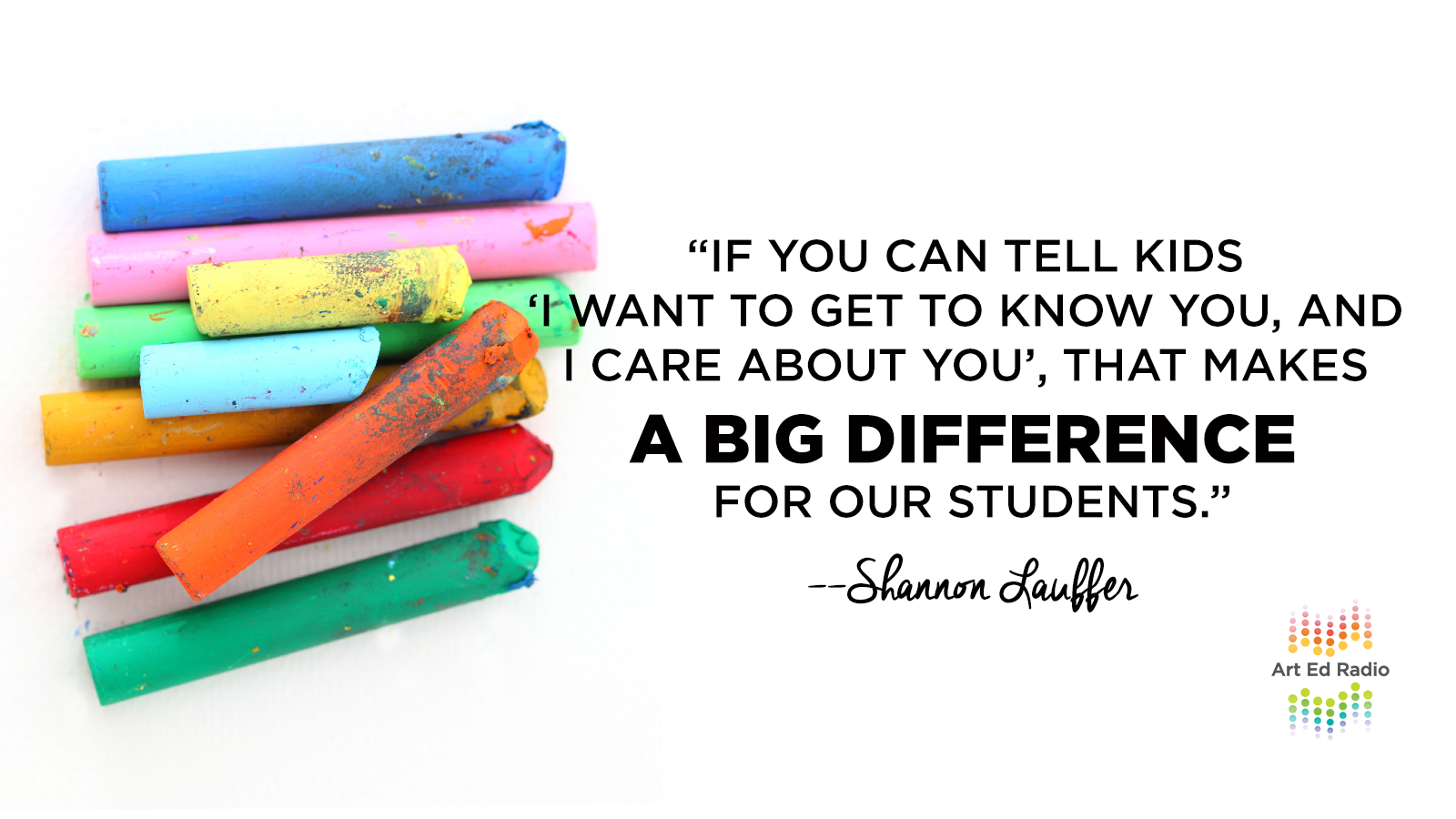
Transcript
Welcome to Art Ed Radio, the podcast for our teachers. This show is produced by The Art of Education and I’m your host, Tim Bogatz. Now, about a month ago, Shannon Lauffer was on the show talking about differentiation. We had a great discussion. She’s so much fun, and she was able to explain a lot of ideas that we don’t think about enough as our teachers. She’s able to explain them in a really simple and really relatable way. Because of that, I think the show was really popular, just a lot of great feedback. Then a couple weeks after that show, she also presented at the Art Ed Now Conference. Her conference presentation was incredible.
Again, just expanding on those ideas about differentiation, showing how you can do it in your room and people just loved it. They went crazy for it. I got a lot of request to have her back on the show. I started looking at when we could get her back on, some other things we could talk about. As I was going through some of her topics that she presented on that we discussed, we ran into something that I don’t think we spent enough time on either in the presentation or the podcast. That was a topic of student interest inventories.
I think that’s relevant right now, because you’re either in your first few weeks of school, or you’re going to be going back soon, and it’s super important to get to know your kids and student interest inventories are the best way to do that. I’ll let Shannon explain that here in just a second when she comes on. Before we dive into that, I want to talk again this week about Art Ed PRO, which is the essential subscription for professional art teachers. It is on demand professional development with video tutorials, downloadable handouts, and all kinds of other resources to help take your teaching to the next level.
With three new learning packs being released earlier this month, the library now has nearly 70 learning packs, which should cover just about everything you need when it comes to professional development topics, but we’re going to keep adding to it. A little over a week, three more learning packs are coming out. One on Miro painting, one on planning for substitutes, and one on rethinking your art room space. It is great stuff. With so many topics already covered and three more packs released on the 1st of every month, it is the professional development you need when you need it. Make sure you check it out. If you’ve not doe your free trial, get it to start at theartofed.com/pro.
All right, Shannon has been waiting for a little while now, so let’s go ahead and bring her on now. Shannon is here with me now. Shannon, how are you?
Shannon: I’m so good. How are you, Tim?
Tim: I am doing really well. I’m excited to talk to you. People are excited to hear from you, because last I talked about this in the intro, but last time you were on, people are like, “I love this episode. This was so helpful.” The after your Art Ed Now presentation, everybody is like, “I need to hear more from her,” and so you’re back. My first question is, how does it feel to be so popular?
Shannon: This is something I’ve struggled with my whole life, Tim. No, I mean, God, what an honor. I don’t know. It’s like I know some things, but I certainly don’t know it all, but I love to share what I know and what’s worked for me. To anybody who will listen, I am down to talk.
Tim: Okay, good to know. That art teacher validation is nice and plus year, like I said, people are listening to you so it’s good and I think it’s been helpful. I wanted to dive in, because something you talked about at the art ed now conference was, well, it was all about differentiation, but one specific thing was interest inventories. I know a lot of people are very curious about those. I don’t know if we have enough for an entire conversation here, but let’s give it a try.
Shannon: Let’s give it a try.
Tim: We’re talking about interest inventory. Can you explain to everybody just at the base level like what are interest inventories that you can use with students? What’s their main purpose?
Shannon: Yeah. Essentially, an interest inventory is exactly what it sounds like. You are using almost a pretest format, a worksheet format to gather some data on your student’s interest. What’s really important to consider is that it doesn’t have to be like, what’s your favorite sport? What’s your favorite hobby? What’s your favorite food? It can certainly have that stuff in it, but it’s also an opportunity to dig a little bit deeper into your students. I really like to find out what parts of art do you enjoy? What media do you want? What do you want to learn this year? What makes you nervous about art?
The main purpose is you’re showing students that you really care. You’re communicating to them, your feelings matter. How you are feeling about this class matters. I think students at any age, K-12 can really appreciate that.
Tim: Yeah, absolutely. I think the biggest thing for me is like you said, those questions that are specific to art class. Because when I do this with my kids, I always talk about being receptive to them and their ideas. I always ask, “What do you really want to learn this year?” If nothing else like that can be a conversation starter with kids, or as I, “Hey, I’m not planning on doing this till 3rd quarter sometime in January.” Just sit tight, but we’ll get there eventually.
Shannon: Exactly.
Tim: You can just share with them what’s coming, which is exciting. If I have a bunch of kids that are interested in a single subject or a topic that I wasn’t planning on teaching, maybe it can direct you into doing something else. For you, I guess the next question is what are the biggest benefits of doing this? Is it learning more about your kids? Is it planning instruction? Is it something else? What do you take away from it most?
Shannon: So, me the biggest benefit here is building those relationships. I feel like this is something that we just keep coming back to, and back to. Building relationships with your students is the single most important thing you can do to run a well-oiled classroom and to consider your classroom management. It’s really hard to communicate that to students when you have 400, 500, 600, 700 students. How do we build a relationship with each one of them? If you can give out this handout and as a blanket statement of like, “I care about you. I want to know about you,” that makes a big difference in students.
I can think back to in English class, I had an English teacher in high school who gave an interest inventory essentially about when you screw up in this class, how do you want me to tell you? That really stuck out to me. It’s like, I don’t want you to call me out in front of the whole class, because I’m going to be embarrassed. I want you to talk to me after class. I want you to leave me a note on my paper. At that time, I remember being like, “Oh, this is so weird that my teacher would ask me this,” but in hindsight, that’s such a powerful thing to do, to give some of the ownership, give some of that power to your students.
Tim: Yeah, absolutely. I want to steal that question right now for my own interest inventory. That’s something-
Shannon: Isn’t that great? Yeah, and obviously, it might be more effective with your older students than your younger students, but even considering students who really struggle with self-regulation, and behavior, and emotional outburst in the classroom. Giving them some power can be really powerful.
Tim: Yeah, absolutely. I do want to talk a little bit more about the relationship building thing. Like you said, we discuss it ad nauseam, but it’s also the most important thing I think we have to discuss it all the time, because it’s vital to running things well. Using that as a springboard, I want to know what kind of things do you want to know about your kids? I know you talked about how you may or may not have certain things that you want to know about their personality, but you do want to know about our class, but do you also want to know learning style? Are you looking for conversation topics? Do you keep it specific to art? Is it a little bit of each of those things? What are you trying to find out? How do you use that to build relationships?
Shannon: I think it has a lot to do with first of, how well you know your kids. If you’re teaching in elementary school and you’ve been there for three years, you have a pretty basic understanding of a good chunkier students. I think as far as conversation is harder, it’s like if I have a kid who’s really, really shy, but maybe he writes down on his interest inventory that he plays basketball, that’s a cool opportunity for me to look at that and be like, “This is a kid that I haven’t quite reached yet.”
I can sit down next to him and be like, “Hey, did you catch the basketball game?” I don’t want basketball but, “I caught a basketball game this weekend. Isn’t that cool?” We’re showing them that first, what you wrote down I saw it and I looked at it, but also a little tiny icebreaker, because even when you’re working with kids, for a lot of them you need an icebreaker. As far as learning style, it’s a great question of like, “What’s your favorite subject in school?” A lot of your kids are going to write down “lunch.”
What they’re telling you is like, “My friends are important to me. Having a chance to talk to others is important to me.” You can say, okay, so if three quarters of my class’s favorite subject is lunch, okay they’re hungry teenagers, but also they want to talk to each other. Maybe I can harness that in a critique, or maybe we can do more collaborative stuff. If your kids like gym, they’re going to be more active learners. They’re going to respond a lot more to that physical media, like clay and sculpture, and architecture.
It’s really taking what you get back on these interest inventories and then synthesizing it to make it apply to your classroom, I guess.
Tim: Yeah, I think that’s really good advice. I actually want to give my own advice based on something that you said as well. It-
Shannon: This is my podcast, Tim. I’m just kidding. Continue.
Tim: Okay, you’re taking over. I’ll just respond to whatever you have to say and we’ll take it from there. No, but you mentioned how things are different when you know kids. I actually have different interest inventories for my intro kids than I do for my more advanced kids, than I do for my seniors. When you get to those more advanced kids who you’ve been working with for two or three years, you don’t need those superficial questions about what’s your favorite subject? You can ask them a lot deeper things like, “What do you want to get better at this year? What did you struggle with?” You can really ask for a lot more information.
Again, like we talked about and what I want to ask you about is guiding your instruction a little bit. Because if kids are saying, “Hey, I really struggled with this last year and I hate it, let’s keep away from it.” Maybe you take that into account or maybe you say, “No, we’re going to get better at it.” In general though, how do you utilize kids’ answers? You talked too a little bit about personality and how that can fit with your instruction, but how do you use interest inventories? How do you use kids’ answers to guide your instruction, to guide differentiation, or things like that?
Shannon: I guess as a self-reflective piece, if I get back from all my students that like, so let’s say I have a lot of these students the year before, and then I get back from a lot of them like, “What’s something you don’t love? What are you not looking forward to?” All of their answer is, “Drawing.” That’s a really good moment for me to look at myself and my teaching and say, “Why? Why don’t my students like it?” Is it that they all feel like they’re bad at it? Is it because they put a lot of pressure on themselves to be a good drawer? Am I just not introducing it in a really authentic engaging way?
As much as interest inventories can be used to guide what and how you’re going to teach your students, it’s also like, “Man, maybe I really miss the mark on this last year.” As a good teacher, this is something that we constantly do. We’re always looking back at what we talked before and say like, “That wasn’t very good. I can do better.” I think simultaneously using them as an opportunity to reflect on your own teaching practice. Then also, looking at your curriculum. If there is a certain media that all your kids are really excited for, if you start seeing them take that downward spiral of like, “I’m losing engagement across the board,” maybe it’s time to shuffle my curriculum around and be like, “Okay, we have to do a ceramics unit real quick, because I’m going to lose them.” Once they’re gone, they’re gone.
Tim: Otherwise they’re going to be gone.
Shannon: Exactly.
Tim: Now, I think that’s really cool. I think one other thing that is important for me with this is just figuring out what kids are interested in, going beyond personality, but what they’re interested in that can maybe be parlayed into subject matter into idea generation. Last time you’re on, you talked a little bit just real briefly about how these inventories can help kids generate ideas. Can you talk about in the specifics of that how that works in your classroom, how you maybe circle back to these inventories later in the year to help your kids when they’re struggling?
Shannon: Yup. I think with a lot of our teachers that I’ve worked with, it’s like students have a hard time generating ideas. Just starting from ground zero and saying like, “Okay, we’re going to do whatever type of project, make six thumbnail sketches.” Kids were like, “Oh my God, six. I did one, that’s the one I want.” Getting them to generate ideas is so hard. For me, this type of interest inventory could take a few different formats. It might be like an actual worksheet that they fill out and keep inside their folder or their sketchbook.
This could have those surface level questions like, “What are your hobbies? What’s your favorite animals? What is your favorite food? Where’s your favorite place to go?” Just so they can refer back to us and be like, “Oh yeah, one of my favorite places is the beach.” Maybe I’ll use a beach inspired landscape. This might take place in more of a creativity exercise. Rather than handing out something that they have to fill out and hold onto, maybe you’re giving them some crazy off the wall prompts, and they have to do a little bit of journaling and sketch noting inside their sketchbook.
Then they might refer back to this to get some ideas. You could say like, “Draw your favorite thing that’s purple that has legs.” Actually now that I said that, I don’t know if there’s anything that’s purple and has legs.
Tim: I don’t know any purple things that have legs, but …
Shannon: Corny.
Tim: That’s where the creativity comes in.
Shannon: Exactly. So, you’re showing students like, “I’m giving you some room so you can think for yourself. You’re going to generate your own ideas, but it’s also going to pull in to your interest as well.” I think those are really powerful again and handing the ownership over to your students and supporting them in that idea generation when it comes to their own interest.
Tim: Yeah, I think that’s really good advice. I think we want to wrap it up here, but before we do that, I want to give everybody just a concrete takeaway here. You and I are going to work together right now and design an interest inventory.
Shannon: Awesome.
Tim: Let’s go through this. How many questions do you think we need? What kind of things do we need to ask? You just went over a few favorites, which I think is always good to add. What would you start with? Then where would you go from there?
Shannon: This is a good question. Again, I want to give you a concrete answer, but I think it really depends on your age group, because of course, your little guys are going to need fewer questions and more visuals. Using like emojis like, “Do you like our happy face, mad face, straight mouth face?”
Tim: Yes.
Shannon: Whereas your older students can write some short answers. I guess I would say, keep it short and simple, five to ten questions. Then you’re going to focus on the type of information you want. For me, it’s like, “Okay, do I need to find out basic information about my students? Do I need to dig into their strengths and their fears if I’m looking to build a culture of risk taking? Do I need to learn more about their learning styles and what they’re interested in so that I can focus on my classroom management?” I guess I would say, determine your purpose.
Tim: Yeah. No, I think it’s good.
Shannon: So yeah, we determine our audience. That’ll tell us how many questions. We determine our purpose. So now, we’re going to make an interest inventory. What do you think is the hardest one to make?
Tim: I don’t know. I think it’s just trying to get kids to open up a little bit. Generally, I like to start with just simple questions like, “What’s your favorite food? What’s your favorite place? What’s your favorite school subject?” Just get them into the flow of answering some of those questions. Then once they’ve spent sometime thinking about their favorite subject, what they like and what they don’t like about school, then I like to transition into questions specific to art like, “What’s is your favorite media? What do you struggle with? What do you want to learn this year and things like that.”
Shannon: I think that’s the key like, “What do you want to learn?” Almost getting kids into the habit of goal setting, which is again like idea generation, really hard. What is your goal? They’re like, “I don’t know.”
Tim: Yes. Sometimes you need to talk kids through that as they’re filling this out.
Shannon: Exactly.
Tim: Just hand out the inventories and then say, “Hey, at the very end, I’m asking you what do you want to learn this year?” Just give them some examples like maybe you want to be better at drawing, maybe you want to be more creative, maybe you want to do more sketchbook work. Just give them a half dozen ideas of what they could answer and just share some of those different ideas for them. I think that’s good.
Shannon: Yup. It also will be super interesting to then revisit that halfway through the class, halfway through the year and say like, “How close are we to meeting that goal? If we’re not close, what do we have to do to get better?”
Tim: Yes. I think that’s great. I generally have my kids just keep their interest inventory inside their sketchbook. Just because I like to refer back to it, the idea thing. We do a project on fears, and we do a project it’s called, “Eating portraits” like portrait of them eating something. I have questions specific to projects that I know are going to be coming. I’ll have them say, list five things that you’re scared of. List your ten favorite foods. Then some of the idea generation is already there. You can revisit that again and again.
Then it’s also good at midterm, at semester to look back at some of those bigger answers like, “Is this still your favorite medium? Did you improve as much as you wanted to? Are we meeting these goals?” It can be a reflective piece as well.
Shannon: Yup, totally agree.
Tim: I think that’s where some of the power lies with, with those interest inventories. I think we’ve probably talked about it enough too. So, I’ll let you go Shannon.
Shannon: We’re done.
Tim: Thank you. I appreciate you hashing out all these ideas for me.
Shannon: Absolutely.
Tim: I hope that it’s helpful for everybody as they start to think about how they can use it in their classroom. Anyway, thanks for taking the time. Hopefully-
Shannon: My pleasure.
Tim: … to have you on again soon.
Shannon: Awesome. Thanks so much, Tim.
Tim: Okay. Thank you to Shannon for coming on and chatting with me. As we did at the end there, I think it’s actually a little bit fun to design those interest inventories. It’s fun to think about what you want to know from your kids, and it’s fun to hear their answers to see what they’re going to tell you about themselves, about their learning, about their interests. One thing that we talked about that I think is important is that different kids are at different levels. Your kids were first coming in for intro to art, you don’t know much about them. Your inventory there is going to be a lot more about their personality, how they learn best what they’re interested in.
As you get to know your kids a little bit better, when you have those advanced kids coming in, maybe you change it up and you ask them more about areas of growth, what media they want to work with more. What are their goals for the year? Things like that. Because you already know them a little bit and so maybe you dive a little deeper with those questions. Maybe you make them a little more specific to art. Just know that this can be adaptable, and you can change them depending on what you need from your kids and what to know what you want to know from your kids.
That’s the biggest idea. Just you want to get to know who’s in your classroom. You may ask them those general interest things. You may ask them something art specific, something about extracurricular activities, something about learning styles, whatever is going to help you teach those kids is the way that you need to design that. Maybe it’s a mix of all of those things plus a little bit more.
The second point that I want to make before we get out of here is as we talked about last week, you need to let kids get to know you too. Maybe discuss your answers with them. Maybe fill out one of the inventories and hang it up on the wall so the kids can see your answers. They want to know that you love the Black Phantom movie or that you’re a photographer, or that you read Harry Potter, The Hunger Games and you listen to whatever kind of music you listen to.
It doesn’t matter what your own interests are. It just matters that you have them, that you are a human, you have a personality, you can share things, about things that go beyond your teaching. You’re not trying to have the coolest answers. You’re not trying to be cool. You’re just trying to be authentic. Sharing about yourself is the best way to do that.
Do something to help you to get to know your kids. Let them get to know you, because when you build those connections, you learn more about who is in your classroom, and the ways in which they learn best. When you do that, your year is going to run so much better than it would otherwise.
Art Ed Radio is produced by the Art of Education with audio engineering from Michael Crocker. Thank you for listening as always. A special thank you for all the awesome feedback about the solo show last week and starting your year off right. I got so many great questions. Keep sending them. I love to hear how things are going in your room, success stories as you start the year. I love answering questions. I love talking shop. I’m trying to get Andrew back for return soon, trying to get The Boss Solo Show soon, so hopefully the next week or two, get the chance to hear from Andrew and also from Jessica Balsley, AOE founder and president.
Whenever I can get her on, it’s going to be a great show. Hopefully that will be soon and we will talk to you next week.
Magazine articles and podcasts are opinions of professional education contributors and do not necessarily represent the position of the Art of Education University (AOEU) or its academic offerings. Contributors use terms in the way they are most often talked about in the scope of their educational experiences.
